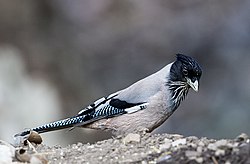| Black-headed jay | |
|---|---|
 | |
| At Palampur in Kangra Valley, Himachal Pradesh, India. | |
| Scientific classification | |
| Kingdom: | Animalia |
| Phylum: | Chordata |
| Class: | Aves |
| Order: | Passeriformes |
| Family: | Corvidae |
| Genus: | Garrulus |
| Species: | G. lanceolatus |
| Binomial name | |
| Garrulus lanceolatus | |
The black-headed jay or lanceolated jay (Garrulus lanceolatus) is a species of passerine bird in the crow family Corvidae. It is found in open wooded country across the Himalayas and into eastern Afghanistan. A relatively large songbird, it has a largely grey body with a black head, an untidy crest, white streaks on the throat, and a pale bill. It is roughly the same size as its close relative the Eurasian jay, but a little more slender overall.




